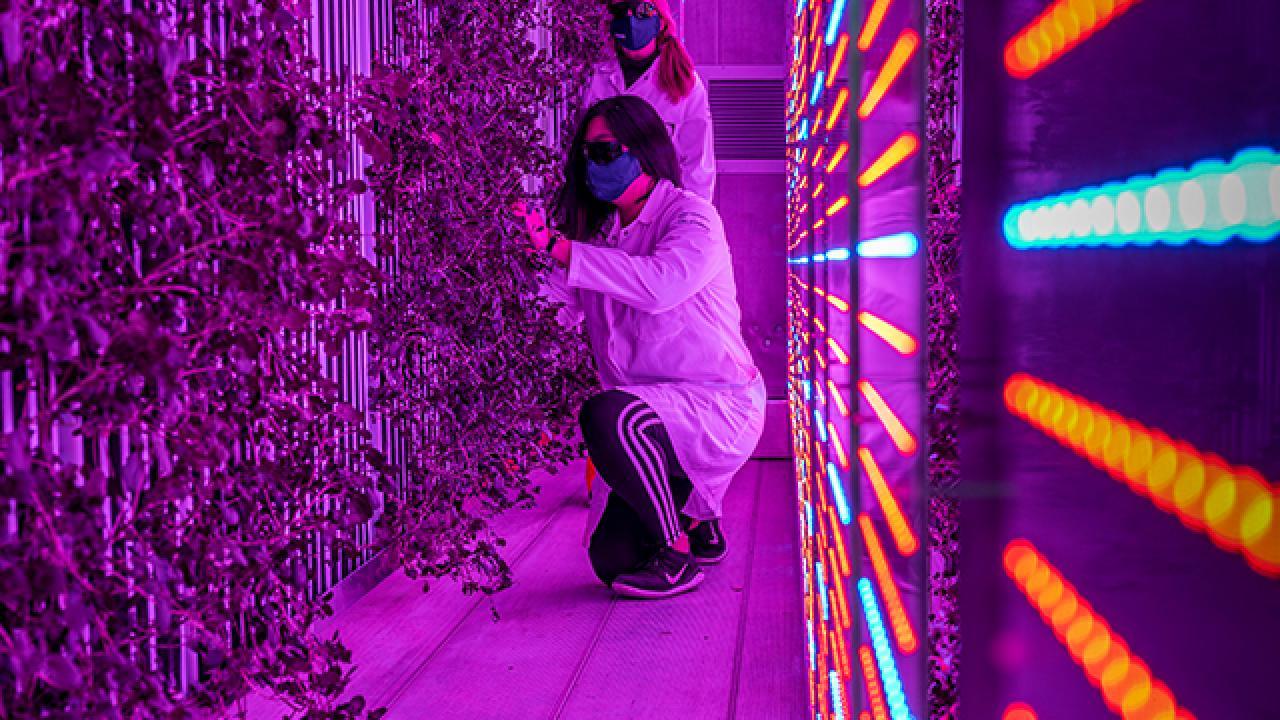
UC Davis vertical farming facility takes hydroponics to a new level
The newest greenhouse on campus doesn’t look like a greenhouse at all. It’s a 40-foot-long shipping container filled with cutting-edge, high-tech equipment that will help UC Davis usher in a new frontier in hydroponic agriculture.
“We’ve begun a research, teaching and outreach initiative on indoor vertical agriculture,” said Gail Taylor, professor and chair of the Department of Plant Sciences, on a recent tour of the facility. “We want to train the next generation of farmers to have skills in engineering, computer science and plants to develop innovative solutions for food security.”
From the outside, the 320-square-foot facility resembles the shipping containers you see trundling down the highway. Inside, it contains a complete hydroponic growing system unlike any other on campus. Rows of vertically hung panels can be filled with plants such as lettuce, herbs and hearty greens illuminated by the glow of iridescent LED grow lights. The hydroponic growing system includes:
- A constant supply of nutrient-rich water that helps plants grow more consistently, using 90% less water than traditional agriculture with a customizable nutrient solution.
- LED light strips, which provide crops with light from only the part of the spectrum they specifically need for photosynthesis, reducing energy waste
- Climate sensors inside the unit that automatically adjust components and maintain the ideal growing environment, including light, water, temperature, pH, carbon dioxide and nutrient levels.
- A mobile software platform giving facility users the ability to monitor, control and track various components in the unit.
“Thanks to the generosity of our donors, specifically the Bixby Endowment, we were able to make the Dean’s vision of helping prepare our students for the future a reality. This new facility will be used as a teaching tool to help students gain skills and understanding of advanced hydroponic growing systems,” said Penny Herbert, the college’s executive assistant dean.
For 10,000 years, agriculture has taken place outdoors at the mercy of the elements, insects, fungi and other plant pathogens. “Plants have been bred and selected for field situations,” Taylor said. “In vertical agriculture, we’ll need new types of plants, and we’ll need to re-engineer them in ways that are suitable for vertical growth.”
In addition to growing select food crops with much less water and precisely measured nutrients, vertical crops require very few chemicals such as herbicides and pesticides. Another advantage is that the pathogens posing risks to human health, such as salmonella and E. coli, can be mostly kept from contaminating the food production system. However, there are challenges and research opportunities on the vertical farming frontier.
“Although these systems have many positive attributes, they use quite a lot of energy and we need to address that,” Taylor said. “So, we’re looking for optimized engineering solutions to take us to the next stage of these indoor vertical crops.”
The shipping container and hydroponic growing system is manufactured by a company called Freight Farms, and is located at the college’s Core Greenhouse Complex on the west side of campus.
(Article written by John Stumbos, senior writer for the College of Agriculture and Environmental Sciences at the University of California, Davis)
